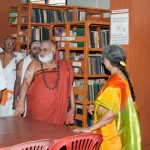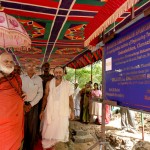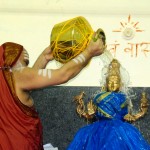
Chennai: JUNE 19-23, 2012
At Meenakshi College
At about 6 PM in the evening on 19th June 2012, the Jagadguru was received at the Arcot Road in Kodambakkam and led in a procession to the Meenakshi College. A traditional welcome was offered by Principal, Dr. KS Lakshmi and the faculty of the college. After Dhuli Pada Puja and a welcome in Sanskrit and Tamil, the Jagadguru blessed the gathering with a Anugraha Bhashanam.
The Jagadguru pointed out the importance of education stating विद्याधनं सर्वधनप्रधानम् (the wealth of education is the foremost wealth). Knowing that the divine presence and grace of Goddess Sharada, the bestower of knowledge, would serve the cause of good education in the college, late Sri K R Sundararajan, the founder of the college and an ardent disciple of Sri Mahasannidhanam (Jagadguru Sri Abhinava Vidyatirtha Mahaswamiji) had donated a piece of land adjoining the college to the Peetham and had prayed for the consecration of a temple for the Goddess. During his lifetime, a temple had been built and consecrated by Sri Mahasannidhanam Himself. His daughter, Dr. K.S. Lakshmi had the wish to build a large temple and has rebuilt it. The Jagadguru said that she had been delaying the opening of the temple with the request that the Kumbhabhisheka be done only by the Sringeri Jagadguru. Her desire was so intense that the Goddess has made it come true on this occasion.
The Jagadguru noted the joy in the assembled devotees on His arrival for conducting the Kumbhabhishekam of the temple, and remembered the words often quoted by Sri Mahasannidhanam:
संतोषं जनयेत्प्राज्ञः तदेव ईश्वरपूजनम्
The wise brings about joy in others. This act in itself qualifies as worship of Ishwara.
The Jagadguru expressed that He had undertaken the Vijaya Yatra for this occasion and to bring about such joy to many. The Jagadguru also stated that one is merely the instrument and it is Ishwara who accomplishes everything, and stressed the need for remaining humble. The Jagadguru remembered the conduct of the unique and massive Ayuta Chandi Mahayaga that was conducted last year in Sringeri. Just because such a Mahayaga was not conducted earlier does not mean that the previous Jagadgurus were not capable of having it performed. In fact, they had blessed that such a Mahayaga take place during our times, and indeed, the Mahayaga took place by the Sankalpa of Ishwara. Having thus illustrated the significance of Ishwara Sankalpa, the Jagadguru blessed the assembled devotees and performed the Sharada Chandramoulishwara Puja in the college premises. The backdrop of the Puja Mandapam was beautifully done with models of the Vidyashankara temple and Goddess Sharada temple at Sringeri, as well as the Gopuram of the new Sharada temple at Kodambakkam.
At 10 AM on 21st June 2012, the Jagadguru performed Bhumi Puja for Sringeri Sharadambal Meenakshi Sundararajan Multi-speciality Hospital. The Jagadguru also graced the engineering college campus and laid a foundation stone for a new Mechanical engineering block. The Jagadguru then inaugurated the Bharathi Theertha Library and visited the Abhinava Vidyatheertha Computer Lab and blessed the members.
Photos
Grand Kumbhabhishekam of Sharada Temple in Kodambakkam
On 22nd June, the Jagadguru performed the Punah Prathishta Kumbhabhisheka at the temples of Ganapati, Goddess Sharada and Sri Venkatachalapathy. The Kumbhabhishekam atop the Vimanas of the temple and the tall Rajagopuram was witnessed by thousands of people. In the evening function graced by the Jagadguru, Hon. Finance Minster of Tamil Nadu, Sri O Paneerselvam, Finance Minister, offered Pranams to the Jagadguru and spoke in detail about the greatness of the Sringeri Sharada Peetham and the Jagadguru. Dr. V R Gowrishankar, CEO & Administrator of the Peetham mentioned about the uniqueness of the Kodambakkam temple saying that while the Rajagopuram at Sringeri when completed would be taller, the Gopuram was the tallest and grandest in any temple for Goddess Sharada in the present day.
In His Anugraha Bhashanam, the Jagadguru raised the question as to which day in life can be termed as a golden day. Today people usually refer to certain days as special or as red-letter days, if they have met a famous personality. In the case of institutions, when a foundation stone is laid or an inauguration takes place, it is considered as a golden day. However there is a verse that states what our ancestors considered to be a special day:
कृतगङ्गोदकस्नानं श्रुतभारतसत्कथम् ।
अर्चिताच्युतपादाब्जं दिनं कल्पशताद्वरम् ॥
That day when you have had the opportunity to be in a holy spot, that day when you have heard the noble stories related to God, and that day when the Lotus Feet of God have been worshipped, is considered better than (even) a hundred years of Brahma.
Our forefathers felt complete if they were able to visit a holy place. They used to await the day when they could get the opportunity to go to Kashi. Their thoughts were, “Would I be able to go to Kashi? Would I be able to complete a holy dip in the Ganga? Would I have the Darshan of Lord Vishweshwara?” They felt that their lives would be purposeful if they were able to visit Kashi at least once in their lifetime.
Similarly, a day on which Puranas and Itihasas such as Mahabharata, Ramayanam, Bhagavatam, Siva Puranam, Devi Puranam, Markandeya Puranam etc., were recited, was considered an auspicious day. Also, a day on which Puja to Ishwara was offered with supreme devotion was considered to be an auspicious day.
We think that our life is getting purposeful as we keep making progress in the worldly life. What we tend to achieve in the worldly life is only enough for progress in this world. All the progress that we seemed to have made in this world will not be of any help in the next world (para-loka) or during a rebirth. Whatever Dharma (or) Ishwara Puja we do in this birth, only those actions will benefit us during a re-birth.
We are Astikas and we all believe in the concept of a rebirth. In every birth, we may need to experience both happiness and sadness. But we always pray that we want only happiness irrespective of the number of births. But the only way to get happiness is Ishwara Kripa and practice of Dharma. If we are experiencing any form of happiness in this birth, it is due to the fact that we have practiced Dharma in our previous birth. If we don’t practice Dharma, we cannot experience any form of happiness.
The Shastras mention that someone who was born rich but did not donate anything in his previous birth is born a beggar in this birth. The Jagadguru stated a very interesting verse to drive home this fact:
अक्षरद्वयमभ्यस्तं नास्ति नास्तीति यत्पुरा ।
तदेव देहि देहीति विपरीतमुपस्थितम् ॥
He who is a beggar today has become one in this birth because he refused charity in his previous birth, repeating the same words, “There is nothing to give” when others begged from him. Today, he has become a beggar and keeps uttering the words, indicative of begging – “Give, Give”.
All the difficulties we are facing in this birth is due to the Adharma we did in the previous birth. When people are doing Adharma, they are not thinking of the outcome of their actions. But when they face difficulties as an outcome of the Adharma, they suffer a lot and realize late that they should not have done the Adharmic action. But what is the use in having a late realization? If you keep your hands in the fire and if your hands get burnt, you should not feel bad that your hands got burnt. The fire doesn’t distinguish between whether its a child or a wealthy person or a scholar or a person with authority. It burns whoever touches it. So too is the case with Adharma.
The Shastras mention that people who do Adharma do so because of Ahankara. “What harm can anyone do to me? Who can question me?” Its with these thoughts in the mind that people indulge in doing Adharma. However, remember यमस्य करुणा नास्ति. Yama, the Lord of Dharma has no compassion. Yama doesn’t distinguish between a wealthy man and a learned man. All that matters to him is the Adharma that he did.
Based on what the Shastras say and what our elders say, all of us have the ability to determine what is correct and what is incorrect. Despite being knowledgeable about this, we continue to make mistakes. If a mistake is committed unknowingly, then a compromise (Prayaschitta) can be worked out. If you keep making the same mistakes knowingly, there is no compromise.
प्रायश्चित्तं सकृदुपनते वा प्रमादात्कृते वा ।
भूयो भूयोप्यवहिततरैः साधिते कः समाधिः ॥
It is akin to a thief who comes out of the jail claims that he is making a mistake, but states he is happy inside the jail because he doesn’t need to work hard for food. If he commits mistakes again and again and ends up going to the jail all the time, what exactly can you do to this thief? People’s behaviour in resorting to Adharma also seems to be like this.
If we read the Puranas like the Mahabharatham, an impression is registered in our minds to live properly. In the Mahabharatha, Bhagavan Veda Vyasa explains Dharma and Adharma by the qualities of Yudhishthira and Duryodhana. Similarly in the Ramayana, Valmiki explains the consequences of Dharma and Adharma by the characters of Rama and Ravana. Despite reading Mahabharatham and Ramayana, if we end up being like Ravana or Duryodhana, what is the point? What happens to your viveka (judgement)? If we do this, what is the difference between human beings and animals? The Shastras say that a human life form is the highest of all life forms. The Shastras claim that human life is the highest only because we have the ability to determine what is right and what is wrong. If you keep making mistakes, what is the use of the human birth?
The Jagadguru then referred to a prayer in the Stotram “कमलजदयिताष्टकम्” written by Jagadguru Sri Sri Sacchidananda Shivabhinava Narasimha Bharati Mahaswamiji where the company of Satpurushas and the opportunity to listen to stories from the Puranas are prayed for. The day in which we are able to do engage in service and Puja to God and receive His blessings is indeed a special day. We refer to Ishwara as an ocean of compassion. Just as the water in the ocean is limitless, the compassion that God has doesn’t have any limits. Unlike people who have preferences towards their friends and family, God remains impartial and blesses the devoted.
The Jagadguru went onto add that He always insists on remembering God all the time, irrespective of the amount of work a person may have. If you ask someone whether they are able to do Ishwara Puja daily, the reply received is usually, “Although I wish to, I am unable to because of my work schedule”. If genuine interest exists, he would wake up early and do the Puja and start for work. That is what our ancestors did. Even if some youngsters are turning out to be Nastikas, they must ask themselves how their forefathers lived. The culture that has been practiced over thousands of years must continue to be practiced.
The Jagadguru then bestowed the title of “Sharada Bhakta ManiH” on Dr. K. S. Lakshmi for her devotion and blessed everyone in the gathering.














































































































